US 66 enters Oklahoma to the grassy, rolling hills of the northeast part of the state and works its way to the southwest towards Tulsa. The road seems to meander through the small towns with a Midwest feel – Quapaw, Commerce, Miami (“Mi-a-ma” to Oklahomans), Narcissa, Afton, Vinita, Chelsea, Foyil, Claremore and Catoosa – many forgotten when I44 replaced Route 66. The original route crosses I44 just a couple times as it wends its way southwesterly into Oklahoma.
Commerce
Besides being the first larger city that you drive through on Route 66 when entering Oklahoma, Commerce proudly claims itself the boyhood home of Micky Mantle, aka “The Commerce Comet”. These two pieces of the city’s history are intertwined on the co-signed “Historic Route 66” and “North Mickey Mantle Boulevard”.
As with most small towns on Route 66, the highway was routed clearly through the downtown. In the case of Commerce, that would be Commerce Street.
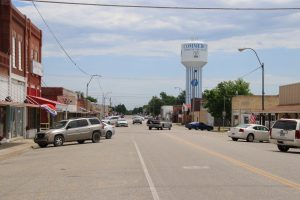
At the end of the main drag, the highway turned to head out of town but there were two iconic businesses that tried to capture travelers on their way in or out of town. Both have been saved and restored and are classic stops for the visitors of today.
The Dairy King is at the very end of Commerce Street, squarely in the middle of the dead end road just before it turns out of town. The quaint little restaurant is hard to miss and just begs for a stop. It’s currently run as burger and ice cream shop by a Mom and son team. The place advertises that it’s the home of the one and only Route 66 cookie. Each one is hand made by Charles Duboise, son of Treva, using a cookie mold that he designed and patented.
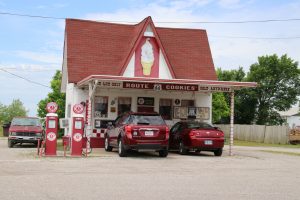
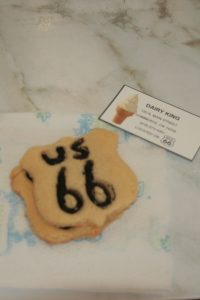
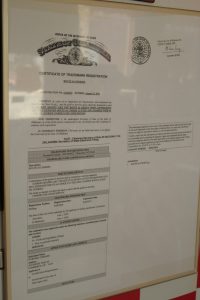
The Dairy King is a popular stop as a burger, ice cream and cookie shop, but the business started as a Marathon Gas Station and had a stint as a rock shop in its prior lives. Today, Charles enjoys the visits from travelers and is more than willing to share his knowledge of the building’s history as well as the history of the area, including the comings and goings and activities of Bonnie and Clyde when they notoriously visited Commerce in April 1934. He keeps scrapbooks of old pictures, news clippings, and collected facts to share and show visitors.
Kitty corner from the Dairy King is another interesting and quirky Route 66 icon. Built out from the side of what appears to be a brick commercial building is the front part of a classic cottage style Conoco Filling Station.
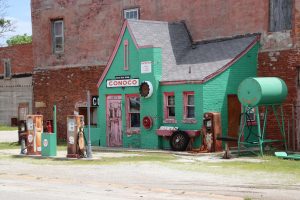 The hole in the wall Conoco Filling Station (as it’s known), was reportedly built in 1929/1930 on the west wall of the last commercial building on Commerce Street, squeezing in a gas station in the narrow piece of land between the building and the highway. Today, the small station is a souvenir/gift shop and museum for Route 66 memorabilia, and maintains a quaint symbiotic relationship with the Dairy King across the street. It probably was a bit more competitive when both businesses were gas stations in the 30’s and 40’s, competing for the passing traffic.
The hole in the wall Conoco Filling Station (as it’s known), was reportedly built in 1929/1930 on the west wall of the last commercial building on Commerce Street, squeezing in a gas station in the narrow piece of land between the building and the highway. Today, the small station is a souvenir/gift shop and museum for Route 66 memorabilia, and maintains a quaint symbiotic relationship with the Dairy King across the street. It probably was a bit more competitive when both businesses were gas stations in the 30’s and 40’s, competing for the passing traffic.
Chelsea
We rolled down the Mother Road as it meandered through the countryside of northeast Oklahoma and a string of the cities and towns – Miami, Narcissia, Afton, Vinita – each with its own special quaint feel and personality before making our way into Chelsea, Oklahoma.
Chelsea started as a rail town, a stop on the Atlantic Pacific Railroad. Initially just a small farm town with a train depot, the town itself gained a bit of a reputation for being the site of the first oil found in the Oklahoma territory in the very late 1800’s.
By the time Route 66 was routed through the town in 1926, the oil boom was in a downswing; the nearby oil fields proved to be of good quality, but the volume wasn’t great and more productive oil fields were located elsewhere in the state. Still, Chelsea did have an oil refinery and a well-developed commercial district that easily switched to serving travelers on the Mother Road. Chelsea embraces its Route 66 heritage with three sites related to the highway.
Just as you enter town from the east, there is a section of the older road configuration (1926 – 1932) that cuts off to the southwest to cross Pryor Creek on the original 1926 modified Pratt through-truss girder bridge built for Route 66. The bridge is listed on the National Register and is open to traffic, albeit with a restricted weight load.
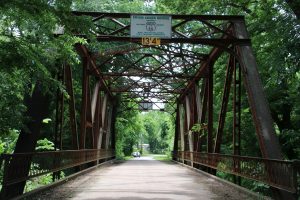
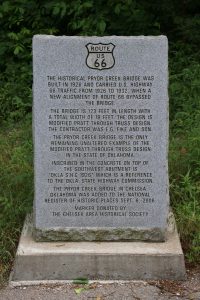
The bridge is neatly nestled into the dense woods that line Pryor Creek.
Also on the edge of town is another site that is listed on the National Register. The Chelsea Motel no longer serves as a way stop for travelers but stands as a ghost of the roadside economy that existed in small towns on the route.
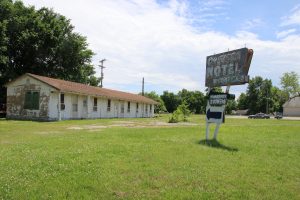
The motel was built in the late 1930’s as traffic on the Mother Road started expanding. A small, family owned motel on the edge of town such as this would be an inviting place to stay after a long day on the road. Establishments like this would provide a backbone to the booming roadside economy that sprang up along the highways across the US. Glitzy neon signs would beckon travelers to stop in the quaint roadside motels to rest for the night.
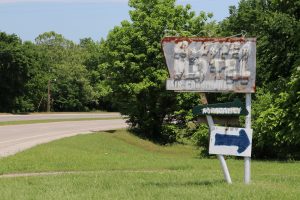
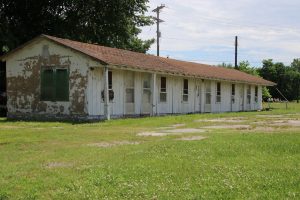
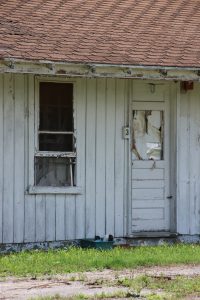
The formula worked for the Mom and Pop establishments while the traffic on the highways expanded and grew. But the growth brought new challenges and the need for bigger and faster highways. By the mid 1950’s, a new turnpike opened about 5 miles southeast of Chelsea, pulling travelers off the two lane highways that networked the small towns of America and on to the faster “super slabs” that joined the more urban centers.
Today, the Chelsea Motel is privately owned and used primarily for storage, standing as a ghostly beacon to a time that was.
When 66 was routed through Chelsea, it was laid out along the tracks on the east side of town and it effectively moved the town center to the east. Route 66 became the dividing line between the east and west sides of Chelsea.
All along Route 66, as traffic continued to grow in volume, pedestrian safety when crossing the highway became an issue. A number of cities and towns along the route introduced pedestrian tunnels to help people in crossing the street. Some of these were first introduced as WPA projects in the 1930’s, but a number were also built into the 1950’s as travel on the highway exploded. This was the case in Chelsea.
Chelsea has turned their 1958 vintage pedestrian tunnel into an interesting stop along Route 66. The tunnel is open and lined on one side by a 90 foot mural dedicated to the history of Chelsea and on the other side by a “signature wall”.
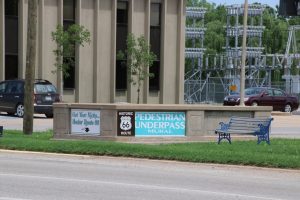
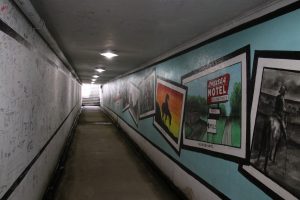
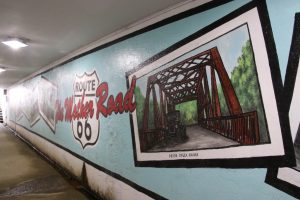
The tunnel was an interesting stop and it afforded an opportunity for a classic set of pictures from both sides of the street.
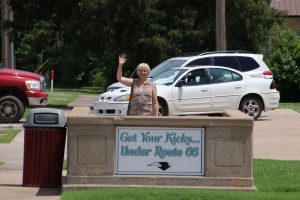
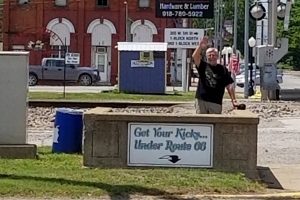
Foyil
Continuing on from Chelsea, we took a bit of a detour along the older alignment of Route 66 through the small town of Foyil, Oklahoma, known as the home of Andy Payne, winner of the First Annual Transcontinental Foot Race. The race, run in 1928, was organized by C. C. Pyle, a sports promoter from Illinois.
Pyle organized the race as a money making activity, planning promotional activities along the way. It was to be run largely on the new Route 66 and was considered a promotion for the newer highway. Pyle offered a large purse of $48,500, with a $25,000 first prize. The sizeable prize money drew international attention in the world of competitive running. Still, Andy Payne, a lad of 20 years, part Cherokee from Oklahoma where he was a track athlete in high school, saw the race as an opportunity. He felt he could accomplish more in three months (the duration of the race) than he could his entire life. Andy lined up some local support and started a training regimen for the race.
When the race started in California on March 4, 1928, Andy was one of 275 entrants. By the end of California, the competitors had dropped to 145, with Payne a distant fourth place. By Amarillo, Payne had achieved second place and he barely eked into first place as he entered his home state of Oklahoma.
The fame and publicity of being the leader cost the native son in his run through Oklahoma, and he ran into Kansas in second place as one of 80 competitors.
Andy regained first place in the Chicago to New York leg, and ran into New York City on May 26, 1928 with a winning time of 573 hours, 4 minutes, 37 seconds. He claimed his first prize winnings and returned to his home state of Oklahoma, a popular home state hero.
Andy used his winnings to pay off his family’s mortgage and used the rest to invest in land that ultimately paid off when oil and gas was discovered. He got married, worked as a newspaper editor for a while and ultimately got elected as Clerk of the Supreme Court of Oklahoma, holding the position for 38 years.
Little Foyil Oklahoma hasn’t forgotten their native son. The original highway is currently named Andy Payne Boulevard and there is a small memorial park and stature commemorating his achievement.
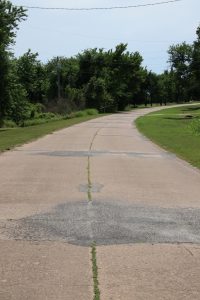
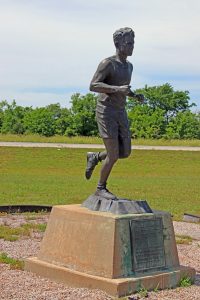
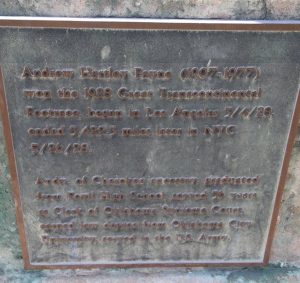
After stopping in Foyil, we continued our drive through Claremore, Verdigris, and Catoosa to our stop for the night in Tulsa.
